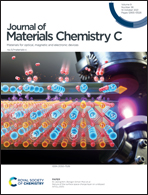A new host material achieving above 75 cd A−1 current efficiency with top-emitting deep-red phosphorescent organic light-emitting diodes†
Abstract
Highly efficient deep-red phosphorescent OLEDs (PhOLEDs) are very important in the practical application of full-color display and automobile lighting. While there are scores of reports dedicated to the development of highly emitting phosphorescent dopants to improve PhOLEDs efficiency, it is a challenge to develop an ideal host due to the severe triplet-involved quenching processes in deep-red PhOLEDs. In this report, a new host material 6-(9-([1,1′:3′,1′′-terphenyl]-5′-yl)-9H-pyrido[2,3-b]indol-6-yl)-6H-indolo[2,3-b]quinoxaline (IQCbTP) was designed and synthesized. The host emission spectrum overlaps well with the guest MLCT (metal to ligand charge transfer) absorption. Single-crystal X-ray diffraction analysis revealed that the host material has a rather short intermolecular π–π stacked distance (3.23 Å), and short intermolecular hydrogen bond (2.55 Å). These features render IQCbTP an ideal host material for deep-red PhOLEDs. Both bottom-emitting and top-emitting red PhOLEDs using IQCbTP as host and Ir(ibpiq)3 as dopant were fabricated and showed an outstanding performance of deep-red emission with CIE x ≥ 0.68. Notably, the top-emitting devices exhibited superior performances compared to the bottom-emitting device, achieving a record of over 75 cd A−1 current efficiency with low efficiency roll-off.



 Please wait while we load your content...
Please wait while we load your content...